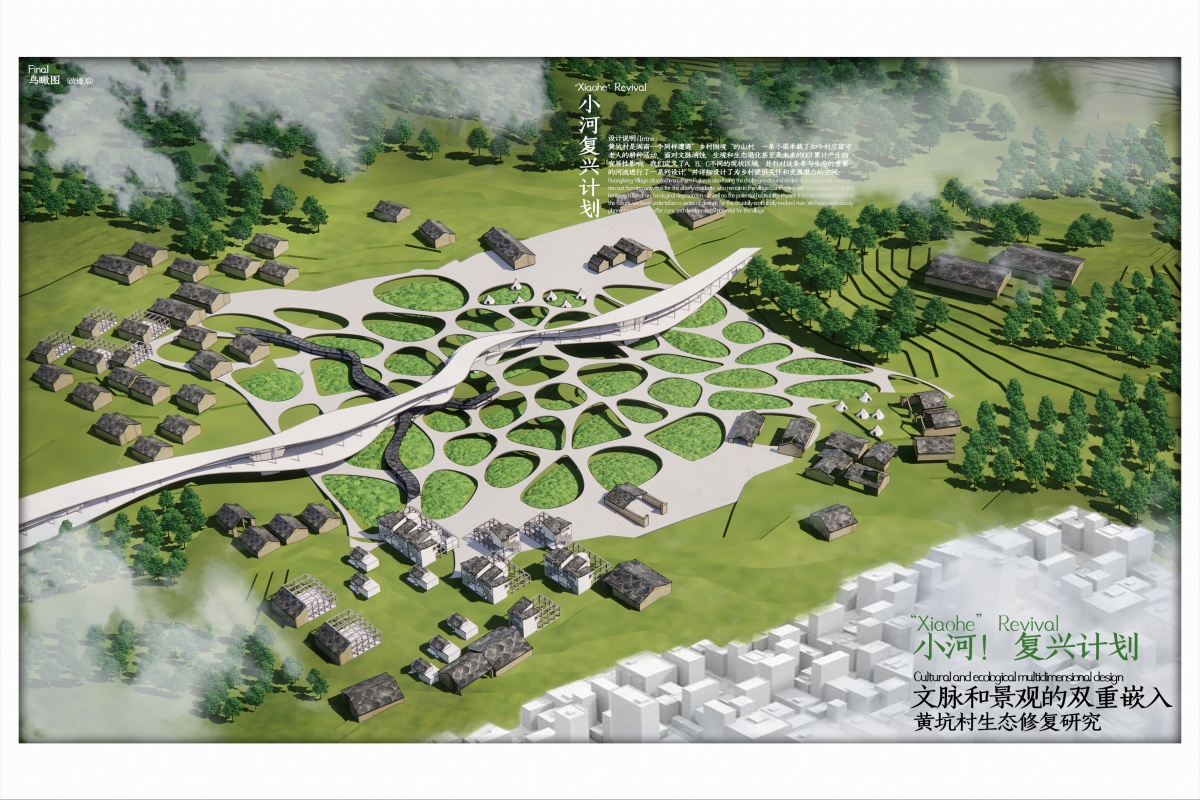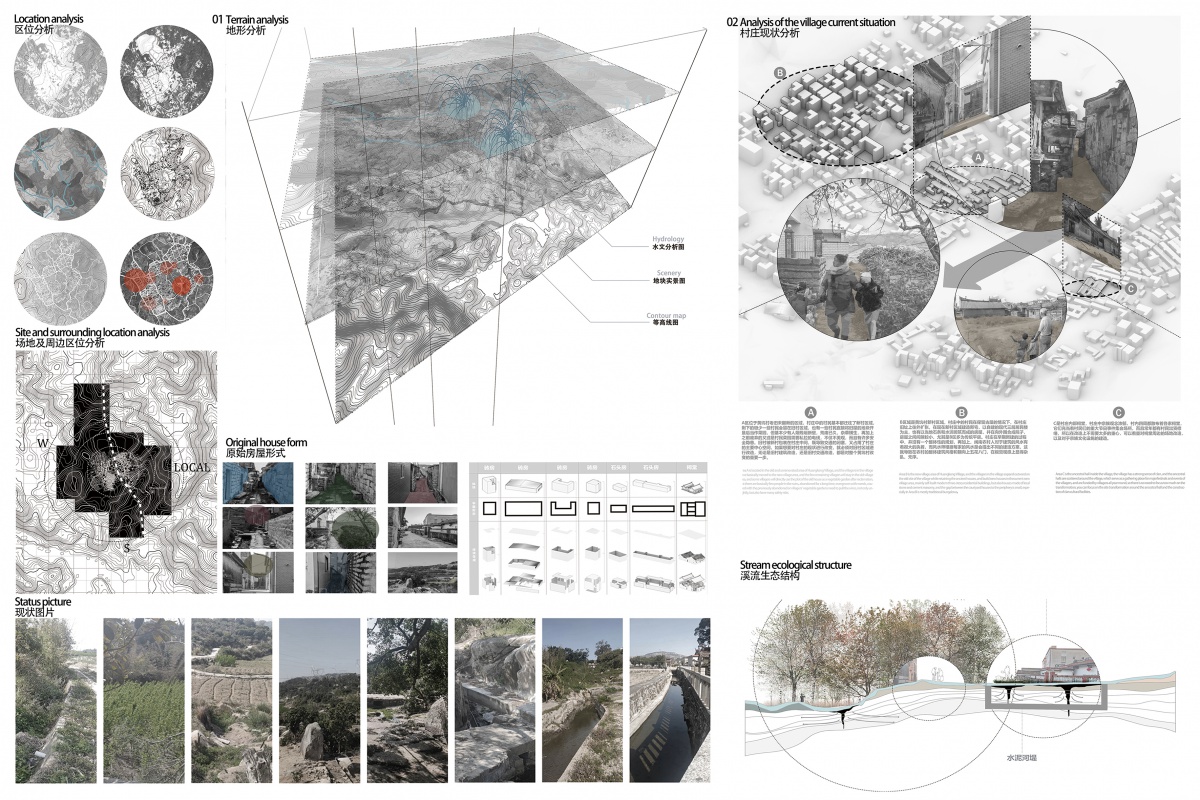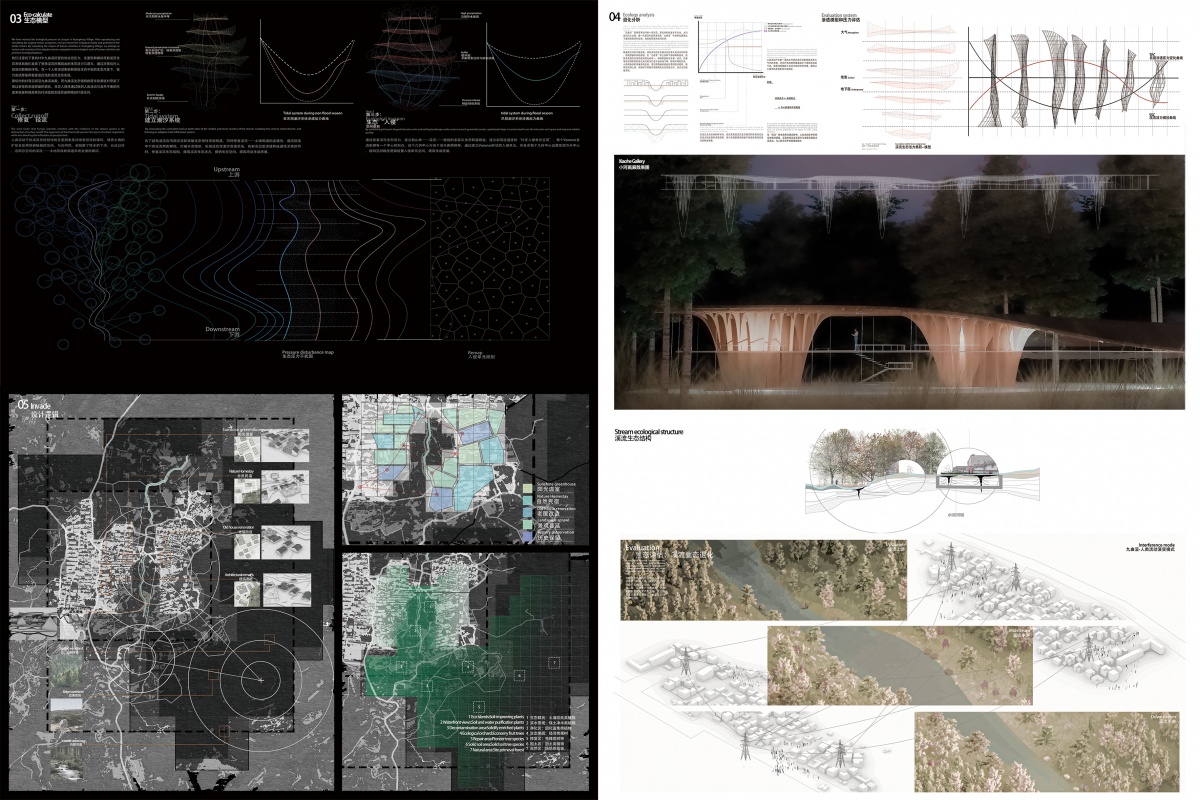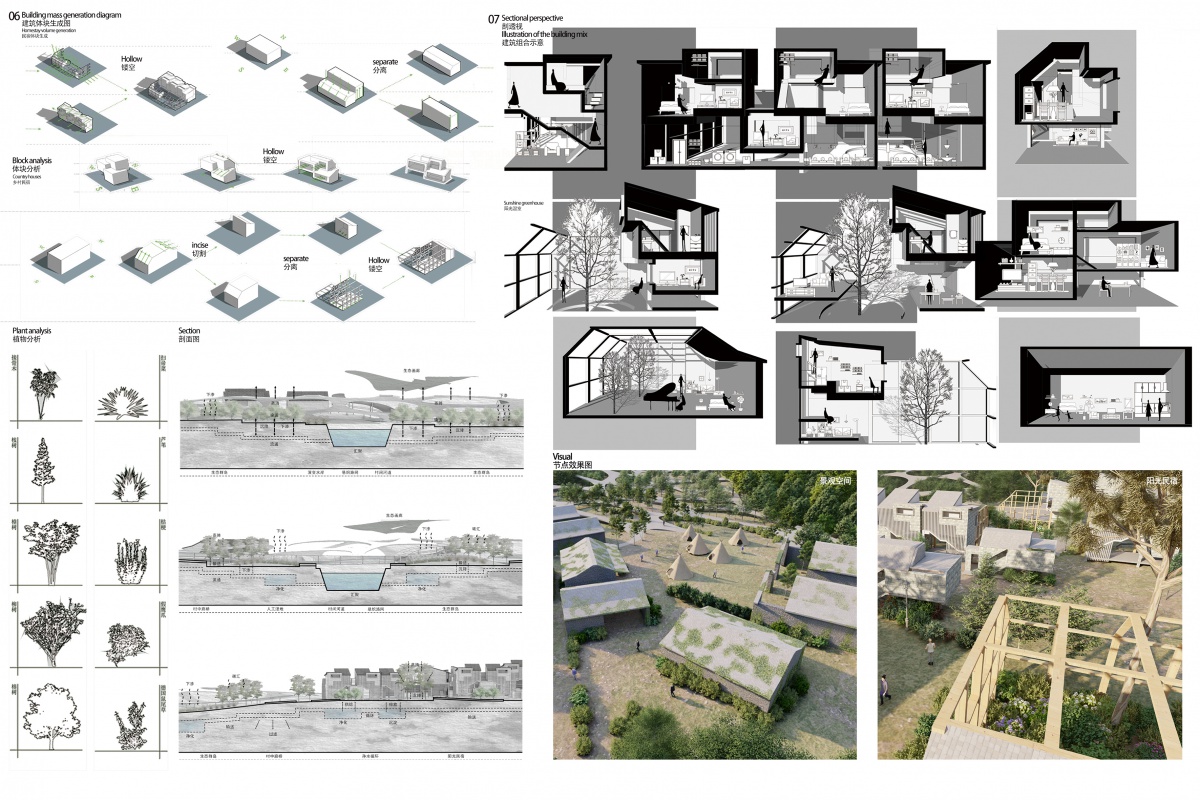
艾景奖组委会
2023/08/30 15:41投票数
154浏览量
2060

改造后鸟瞰效果图
小河!复兴计划——文脉和景观的双重嵌入 项目内容为通过调研、论证和优化黄坑村内河流周围的生态过程,营造丰富的修复型乡村空间。复兴计划中的小河是如今身处“乡村困境”的黄坑村的主要灌溉水道,从村庄中轴贯穿,流向山林密布的山谷。而几近全部流失的青壮年常驻人口让整个村庄显得少有生气。 这条小河如今面临着许多生态问题,径流退化、农药积累、非汛期断流等等。但我们看到了这条小河可能带给村庄的生态活力,以及在时代下构建新的黄坑文脉的可能性。 The project involves conducting research, analysis, and optimization of the ecological processes surrounding the river within Huangkeng Village. The aim is to create a revitalized restorative rural space. The rejuvenation plan focuses on a small river that serves as the main irrigation channel for Huangkeng Village, which currently faces challenges typical of rural areas. This river runs through the village axis and flows into a valley surrounded by forests and hills. The significant lack of a resident population, especially young adults, has rendered the village less vibrant. The small river itself faces various ecological challenges, including runoff degradation, pesticide accumulation, and dry periods outside of the flood season. However, we perceive the potential of this river to bring ecological vitality to the village and to establish a new narrative for Huangkeng in the context of modern times.
设计说明

黄坑村场地综合现状分析
Key 1 :文脉 聚落发展是人类社会扩张的一种规律。在乡村振兴所面临的困境下,被打破的聚落系统会成为乡村修复中遗忘的部分。 我们观察聚落的形态发展,在中国工业化后,社会经济结构和实体空间的扩张,道路将其链接,打破了远离增长的原生聚落形态。新的技术“入侵”或许会形成独特优势的工农综合体,但是社会信息互联带来的桎梏,最终导致人口流失,让乡村空间、聚落不复从前。有些乡村的资源有限,在几十年后的今天,这种文脉上的消蚀和撕裂更为严重。 黄坑村位于闽南,聚落形成的历史可以追溯到宋末以后,其来自于人口南下迁徙,散布在各处。黄坑村地势高峻,只有回报周期长的生态资源。 今天的黄坑村文脉消蚀同样严重,自给自足的山村变得人去楼空,而生境质量与过度开发的恶性循坏导致环境也大不如前。老人和孩子留守在山上,匮乏的综合教育和缺少陪伴令人不安。 The intrusion of new technologies perhaps created unique advantages for agro-industrial complexes. However, the constraints brought by interconnectivity of social information ultimately led to population outflows, reshaping rural spaces and settlements irrevocably. In some villages with limited resources, several decades later, the erosion and tearing of such cultural fabric have become even more pronounced. Today, Huangkeng Village faces severe cultural erosion. The self-sufficient mountain village has become deserted, and the deterioration of habitat quality, combined with the vicious cycle of excessive development, has diminished the environment. The elderly and children are left behind in the mountains, lacking comprehensive education and companionship, creating a sense of unease.

生态设计逻辑和小河画廊
Key 2 :景观生态 黄坑村没有实现产业转型,山上留守的村民仍然在耕种,一条穿过村庄并将其一分为二的小河引人注目。这或许是工业开矿时的引水,如果小河本来就存在,那么黄坑村的村落也将围绕这条小河展开,黄坑村的古村落就在小河中游向两侧徐徐展开。 这条小河现在承载着村庄上、中、下游的灌溉,硬质的河堤让它十分纤细,汛期水位高涨,但是旱季却出现断流。村民说曾经有几口井,可以打到地下水。这意味着村庄的径流循环系统发生了退化。 往往在聚落的扩张中,硬质地面、耕地等人类活动会影响径流循环。这条小河是村落径流循环的主体之一,具有生态潜力,通过更有力的径流系统来提高村庄的生境质量。 Huangkeng Village has not undergone industrial transformation; the villagers who remain on the mountain still engage in cultivation. A noticeable small river runs through the village, dividing it in two. This river might have been artificially channeled during industrial mining operations. If the river had existed naturally, the village of Huangkeng would have likely developed around it. The ancient village unfolds gently along the middle reaches of this small river. Today, this river serves as irrigation for the upper, middle, and lower parts of the village. Its sturdy embankments make it quite slender. During the flood season, water levels rise significantly, while in the dry season, the river may run dry. Villagers mention the presence of several wells that used to access groundwater. This signifies the degradation of the village's runoff circulation system. Frequently, human activities like paved surfaces and cultivated land during settlement expansion disrupt runoff circulation. This small river is a vital component of the village's runoff circulation, holding ecological potential. Enhancing the village's habitat quality can be achieved through a more robust runoff system, as this river is one of its primary components.

设计形式呈现——河流周围古村落分型改造与废墟景观重生
我们最终计划围绕这条小河重新构建生境,并打造一些教育意义和适老化的空间,以此建立新的黄坑村文脉。 通过对小河周围两侧的古村落的调研,我们决定保留古村落大体的砖石结构,并且通过多种不同的分型方式,结合街道性格呈现出了丰富的功能空间。引入相对轻质的钢框架在道路密度高的古村落区整合出阳光温室和民宿用房,实现景观空间的建立和串联。 而小河作为生态学和形态学双重意义上的廊道,连接着山谷的生态斑块,我们将通过一系列生态措施如潮汐公园和生态农业等来激活这一生态特征,同时潮汐公园的植物配置将形成隔离带和潮汐净化区,以避免地面塌陷并净化常年河边耕地带来的农药累积。潮汐公园的不同季节将提供不同经济价值的景观作物,比如春种夏收的向日葵园,和汛期涨水的芦苇滩。 小河是一个充满生气的符号,我们在小河的形态周围打造一个艺术向的线性空间——小河画廊,作为映画多感官体验的空间,来填补下一代的相关教育。 Through research on the ancient villages on both sides of the river, we've decided to retain the brick-and-stone structures of these villages, presenting a diverse range of functional spaces through various typologies that align with the character of the streets. Introducing relatively lightweight steel frames into areas with high road density in the ancient village, we've integrated sunlit greenhouses and guesthouses, establishing and linking the landscape spaces. The small river serves as a corridor in both ecological and morphological senses, connecting ecological patches within the valley. We will activate this ecological feature through a series of ecological measures, including a tidal park and ecological agriculture. The plant layout in the tidal park will form buffer zones and tidal purification areas, preventing ground subsidence and purifying the farmland adjacent to the river from pesticide accumulation. The small river symbolizes vitality. Around its form, we are creating an artistically oriented linear space - the Riverine Gallery. This space will provide a multisensory experience to engage the next generation, contributing to their education.
设计感悟
设计亮点
投上一票